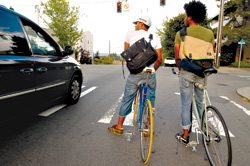Tim Eyman be damned. This month, Seattle voters chose once again to tax themselves, approving the $365 million levy-lid increase known as Proposition 1. It was the seventh time in less than 10 years that civic-minded Seattleites have stepped up to raise their property taxes. The latest hike, put forward by the mayor and City Council, will mostly pay for street and bridge improvements to smooth the way for car and truck traffic.
But Mayor Greg Nickels and the council spread the wealth around, pledging to spend at least 18 percent of the Prop. 1 proceeds—about $70 million or so—on bicycle, pedestrian, and safety programs. That won over groups such as the Sierra Club, Transportation Choices Coalition, and the Cascade Bicycle Club, which supplied Prop. 1’s “Statement for” in the Voters’ Guide. (No sign in the guide of Prop. 1’s biggest financial backer, Paul Allen. The measure will spend big to spruce up the roads in South Lake Union—most significantly the “two-way Mercer” makeover.)
Prop. 1 opponents, including The Seattle Times and the Municipal League of King County, argued the bill was stuffed with “nonessential” projects. Even many supporters doubted that tax-me Seattleites would bite yet again. But bite they did, by a 6 percent margin. The city’s annual spending on bike facilities will now roughly quadruple, according to David Hiller, advocacy director for the Cascade Bicycle Club.
So how to spend the (relative) riches? The city is expected to rely heavily on a long-awaited (by velo-geeks) Bicycle Master Plan. This giant document, a draft of which will be put out for discussion at two public meetings next month, will offer recommendations on how to make bicycling safer and more appealing throughout the city, street by street. It’s being put together by a Maryland-based consultant and will call for a variety of on-street bike lanes, “sharrows” (a little bike icon painted on the pavement, meant to encourage drivers to share the road), and other improvements, according to preliminary maps released last month.
Many of these additions will coincide with larger repaving projects, Hiller says, making them fairly cheap add-ons: as the road is redone, a stripe is added for bikes.
But the strategies promoted in the Master Plan are not unanimously supported, even by cycling partisans. In particular, the use of on-street bike lanes—such as the ones that currently line Second Avenue downtown and Dexter Avenue between downtown and Fremont—has long been controversial. Some cyclists think they’re more dangerous than riding in traffic because they force riders to travel directly alongside endless rows of parked cars—cars whose doors can swing open at any moment. The lanes also can put the cyclist in the line of turning vehicles.
“I’ve been hit in that one on Second Avenue several times,” says Todd McMeen, a veteran bike messenger with KNR Couriers. It’s safer to ride with car traffic in the regular lanes, he says.
A small but vocal faction of the Cascade group makes the same argument, including Shaun Darragh, who wrote last month on the club’s message board: “I lost track of the number of collisions there [at Pine Street and Bellevue Avenue on Capitol Hill] that I would directly attribute to poor bike-lane design and inexperienced cyclists being lulled into feeling safe in the lane.”
Hiller dismisses the bike-lane opponents as “a small group of cranks” who are “undermining a plan that will bring more bikes on the road.” Bike lanes, he says, “provide safe separation within the available roadway. We’re not some small European city with little streets; we have to delineate some space.” The “just- assert-your-rights” philosophy won’t work for most riders, he says.
Rebecca Slivka, a computer consultant who runs a Web site called bicyclewatchdog.org, says the larger problem is not a lack of lanes but “drivers who could give a shit about cyclists; who are ignorant, selfish, or in a hurry.” She’d like to see more of the Prop. 1 money spent on educating Seattle motorists about cyclists’ right to be in the road, using signs and better enforcement of current law. “Things like that will reduce conflict and make the city more welcoming to riders,” she says. “But people want to say: ‘We built this thing.'”
Even if the Master Plan is approved by city officials, “There’s always that chance they could ignore it,” says Bill Schultheiss of Maryland’s Toole Design Group, which is preparing the plan.
“This city has some plans that it adheres to very well, some that it does not,” says Hiller. “It’ll be our job to police the heck out of them.”
Spending of Prop. 1’s proceeds will be overseen by a committee including representatives from the city’s pedestrian, bicycle, and freight advisory boards. Peter Whitehead of Nelson Trucking, a member of the freight board, says he’s concerned about promoting more bike traffic in industrial areas of the city. “Trucks just don’t see little bikes, and the bikers are arrogant,” he says.
While the battle over extending the Burke-Gilman Trail across industrial parts of Ballard—the so-called “Missing Link”—has gotten plenty of attention, Whitehead said he worries about encouraging more cycling along the busy piers south of downtown. “That’s right across from the main arteries of our economy,” he says.
Cyclists are tough to compete with politically, though, according to Whitehead. “They are an 800-pound gorilla,” he says. “They are very vocal; their people come out in force; they do a good job of getting what they want.” Now they’ll just have to decide what that is.




